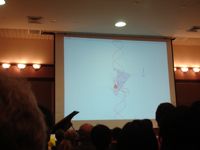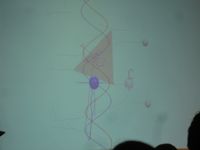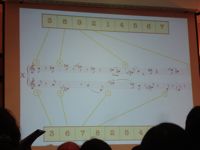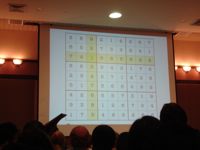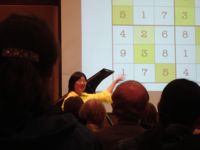The Mathematics in Music
I went to a very interesting performance today: “The Mathematics in Music: a concert-conversation with Elaine Chew”, in Killian Hall at MIT. Elaine is visiting Harvard for the year from USC, where she is a professor. She has an amazingly broad background that is super-pleasing… having studied math, computer science, music performance, and operations research.
Elaine performed four piano pieces, three of which were composed just for her, that use playful tricks in math as compositional inspiration. Some of these tricks included:
- Composing with a meter determined by the numbers in a row (or column) of a completed Sudoku puzzle. This piece had a different time signature for every measure… 3/8, 1/8, 7/8, 9/8, and so on, accompanied by an entirely different sequence for the other hand. I was very impressed that anyone could play a piece like that. Listening in the audience, you want desperately to tap your foot to ground yourself in some kind of beat, but it’s impossible.
- A bi-tonal piece: right hand and left play in different keys. Chew likened this to patting your head and rubbing your belly at the same time.
- Genetic programming: The composer applies the idea of genetic mutations and substitutions on a familiar theme at the note and phrase level, which results in some jarring effects.
Elaine and her colleague, Alexandre Francois, developed a way of visualizing tonality called MuSA.RT, which accompanied her during two of the pieces. MuSA.RT shows (as a real-time accompaniment to MIDI-enabled piano) the changing notes and key of the piece along a spiral that is kind of like a 3-D version of the Tonnetz. More on the model in Elaine’s paper (PDF).
John is leaving
This is not a “best thing”, but it feels momentous… John Maeda is leaving the Media Lab. He’s off to RISD at the end of the month.
John gives his last lecture this Friday, 3:30pm, in Bartos. His students made some awesome posters to commemorate his time here.

Making Terminal nerdier
I just sat in on a Max OS X Leopard Development Tools talk, where I heard about a few things that are pretty nerdy and pretty silly. nerdy + silly = awesome
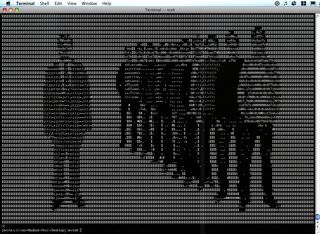 Play QuickTime movies as ASCII in your Terminal — The code + app are here, although I had to rebuild mine to get it to work. This has been on the nets for a while, but it was new to me.
Play QuickTime movies as ASCII in your Terminal — The code + app are here, although I had to rebuild mine to get it to work. This has been on the nets for a while, but it was new to me.
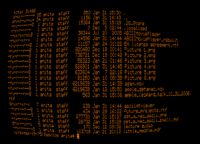 Download GLTerminal and get a working terminal window with graphics that simulate those old green/amber, flickering, curved-on-the-edges terminals I remember from the early 80s. Complete with low baud rate simulation (hahaha), and adjustable flicker rate. Here’s a version for 10.5 Leopard (make sure to set “Preferences” first, as described on this page).
Download GLTerminal and get a working terminal window with graphics that simulate those old green/amber, flickering, curved-on-the-edges terminals I remember from the early 80s. Complete with low baud rate simulation (hahaha), and adjustable flicker rate. Here’s a version for 10.5 Leopard (make sure to set “Preferences” first, as described on this page).
Also mentioned was code that enables you to read from the accelerometers and light sensors in your Apple laptop. Google Code has provided the Quartz Composer patches that grab the same information. I’ve been dying to mess with this, but don’t have time these days. I’m hoping one of my friends will read this, and then make something totally awesome with it.
Now off to watch all those “Get a Mac” commercials I’ve been missing…
The chirping of bats
Neuroscientist and bat researcher Cynthia Moss came to talk at MIT this afternoon about how bats use direction, timing, and frequency in their sonar vocalizations to locate insect prey. Her presentation was (wonderfully) full of video, in which the picture and audio had been slowed down by about 16 times, so that we could better see and hear the bat activity.
I was astounded at how interesting these bat vocalizations are. Here I thought bats were like little submarines, just going, “beep… beep… beep…”, but they vary the frequency and pitch range of their chirps dramatically while tracking a target. I found links to some similar videos (short, longer) on Dr. Moss’s group website.
Strangely, this reminds me very much of Ed Boyden‘s “logarithmic time planning” on his Tech Review blog. Makes me think we are all little bats, chirping in our own way when the right bug comes along.
More info on this work can be found here:
Auditory Scene Analysis by Echolocation in Bats: Insect capture Studies & Aim of the Bat’s Sonar Beam
Martin Wattenberg’s advice to me
Tonight I went to see Martin Wattenberg (from IBM’s Visual Communication Lab) talk about visualizing the patterns in Wikipedia edit histories (see history flow and chromogram). It was very fun, very interesting, and makes me think it’s possible to have a job that feels like play.
Afterwards I asked Martin if he had any advice for me, as I’m about to embark on my Masters thesis work, which is really just a big visualization project devoted to looking at people’s music collections. I was wondering what kinds of coding tools he’d recommend. (All of his Wikipedia visualizations were built in Java.) He said, “You’ve got one big question to answer first… Do you want to put this on the web, or not?” If I want it on the web, he says, go Flash; if not, try Processing. And he strongly suggested making it for the web, because that creates the possibility for an instant community and lets the project take on a life of its own.
Thursday, November 15, 7-9 pm
Visualizing Wikipedia: A tale of life, love, and bureaucracy
Martin Wattenberg and Fernanda Viegas (in spirit) , IBM Visual Communication Lab
Abstract: We report on Wikipedia’s evolution from a curiosity to a point of first
reference for millions. Applying data visualization techniques to
Wikipedia’s historical archives uncovers a story in three acts: life, love,
and bureaucracy. “Life” refers to the impressive ability of Wikipedia to
heal itself after vandalism and errors. “Love” is reflected in the
overwhelming scale of individual production and the passion shown by devoted
editors. And bureaucracy–an unexpected aspect of a free-spirited
community–is becoming prevalent as the site scales, with emerging
formalized processes and roles that help ensure quality.
Hiking on the water
I got really lucky today at the MIT Sailing Pavilion. I had gone back to brush up on the skills I’d learned last Sunday, and when I was all done practicing by myself (having narrowly escaped both capsizing on the first turn, and concussion to my head on a jibe), I ran into one of my instructors, who offered to take me out one-on-one, and teach me how to sail upwind.
With some forceful commands and good patience, Bashar taught me how to do these things on my own:
- Hiking — leaning way out on the boat towards the wind, to counterbalance the sail being pushed strongly in the opposite direction. It’s FUN. The boat heels so much that I could swear we were (intentionally) inches from capsizing. The photo below (by flickr user good_day) shows what it looks like to hike out.
- Running — sailing directly (or almost directly) downwind. This felt very relaxing and peaceful, but I am told to watch out for the unexpected jibe.
- Close-hauled — trying to sail as directly upwind as you can, by pulling the sail in close and zig-zagging, tacking at ~ 90° angles.
I had tons of fun and even got to sit in the boat while we raced with the Advanced Racing class. My thighs and back are killing me, though, and I might not be able to walk tomorrow. :-D
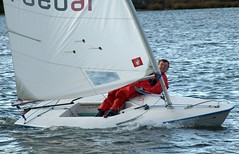
Sailing
 I went to “Sailing Bootcamp” yesterday at the MIT Sailing Pavilion along the Charles River. I learned about wind, water, boats, and most importantly, what it feels like to pull on a sail and turn a rudder on a Tech Dinghy. My partner and I magically avoided capsizing, and only collided five times with other dinghies in the crowded class. (“Dinghy”!)
I went to “Sailing Bootcamp” yesterday at the MIT Sailing Pavilion along the Charles River. I learned about wind, water, boats, and most importantly, what it feels like to pull on a sail and turn a rudder on a Tech Dinghy. My partner and I magically avoided capsizing, and only collided five times with other dinghies in the crowded class. (“Dinghy”!)
We had an easterly breeze on the Charles yesterday, which seemed to pick up and die down very suddenly. I’d never had reason to notice how dramatic those changes can be around here, and I’m excited about the challenge it poses for some future sailing.
Here’s my excitable and entertaining instructor, Henry, giving a high-tech demo of wind interacting with a sailboat:
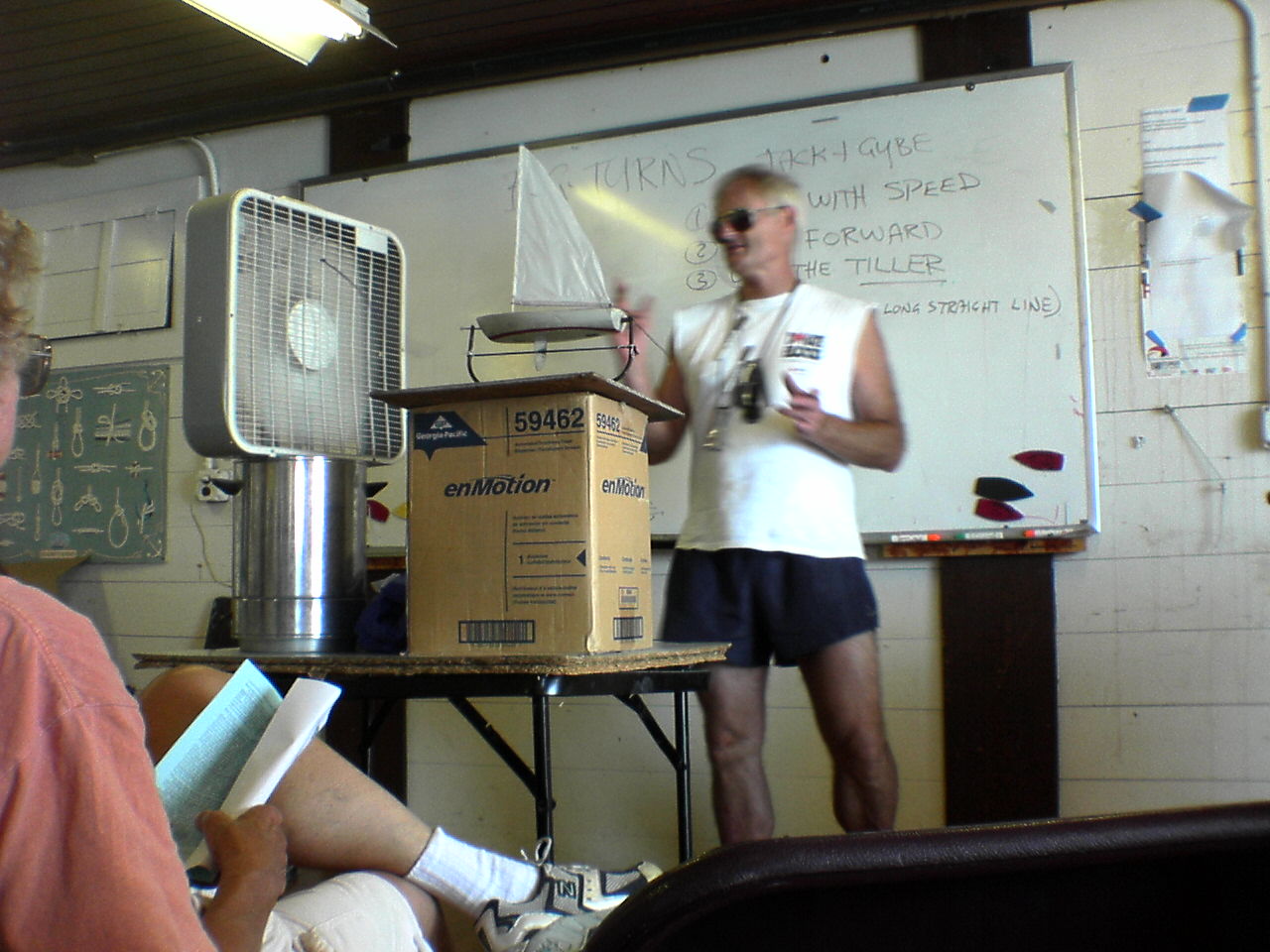
What’s a radial tire swing?
On Friday I was invited by one Mark F to play on the tire swing at Senior House. We walked over there from the lab, through the house and out onto the back courtyard. There, hanging from a large tree, was a tire swing. Except… the rope was so long that the tire was sitting on the ground. “But Mark, the rope’s too long.” “Yep,” he said, with no sign of any concern. I was kicking around some leaves right next to it, while I thought Mark was adjusting the rope, when suddenly he just said, “This tire swing is different, because it swings radially!” And he took off running with the tire swing in tow.
Turns out that this tire swing works just like tetherball, where you are the ball, and the tree is the pole. You run around the tree, with the rope taught, and run and run until at some point your feet must leave the ground (jumping intentionally at this point is recommended). Then you fly through the air, the rope wrapping around the tree, and you’re pulled higher and higher, closer and closer, until you are running around the tree itself. Mark has this skill perfected, and he runs around and up the tree, and then he jumps out, and into the unwrapping spin. He wraps and unwraps, over and over, never slowing down. It really was insane.
I tried it three times. The first time I ended up skidding backwards on the concrete, on my head and upper back. The second time, I skinned my shoulder on the tree (turns out it’s pretty important to keep facing the tree; otherwise you end up wrapping yourself very quickly into it. The third time, I managed to actually step along the tree at the tightest part of the swing cycle, push out gently, and unwrap, eventually coming to rest and damn proud of it.
What’s the sound of one piano dropping?
 Yesterday was MIT‘s “drop date”, the last day during which you can drop classes. MIT’s drop date tradition is, of course, to drop a piano off of the top of Baker House.
Yesterday was MIT‘s “drop date”, the last day during which you can drop classes. MIT’s drop date tradition is, of course, to drop a piano off of the top of Baker House.
I went to this event, expecting a cacophonous crash full of pops and twangs and vibrating strings, and wood splintering everywhere (“Should I be wearing safety goggles?”). And, to my dismay, the piano had no strings (hence, no crazy resonating sounds), and it really just sort of made a simple wood-breaking sound that seemed too short after what seemed like a very long fall. Still, it *was* loud, and was very silly. So I was happy.
Luis took a video of the occasion. And this guy has some great photos from last year’s event.
More:
- Matt McGann’s blog post about the event (from 2005)
- The Baker House page (from 2005)
- “Bruno – A unit of volume resulting from a piano falling six stories onto Amherst Alley from the roof of Baker House.” ((http://www.mitadmissions.org/topics/life/hacks_traditions/jargon.shtml))
The mysterious Coriolis force
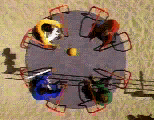 I remember the term “Coriolis force” from some ancient high school physics class, I think. But when Joe P showed us this phenomenon again in class last week, I could swear I’ve never ever thought about it before. It’s a little baffling to me at the moment (and therefore worth thinking about!).
I remember the term “Coriolis force” from some ancient high school physics class, I think. But when Joe P showed us this phenomenon again in class last week, I could swear I’ve never ever thought about it before. It’s a little baffling to me at the moment (and therefore worth thinking about!).
Compare the simple video on the Coriolis force Wikipedia page with the merry-go-round video on this page. Now figure out how cyclone winds rotate along the Earth’s surface… and you’re all set!
